Lean Project Management Principles to Secure Government Work
VerifiedAdded on 2023/03/17
|13
|4187
|32
Report
AI Summary
This report examines the implementation of Lean Project Management (LPM) within a project consultancy to secure government contracts. The memo, addressed to the board of directors, outlines the initial reasons for adopting LPM, focusing on waste reduction and efficiency improvements to meet government tender requirements. It details the benefits to both internal stakeholders, such as management and employees, and external stakeholders, including the government and suppliers. The report identifies critical success factors, including profit generation, reduced waste, and increased employee participation. Furthermore, it discusses the importance of supplier relationships and employee participation in achieving successful project outcomes and securing future government contracts. The analysis emphasizes the positive impacts of LPM on project execution, stakeholder satisfaction, and the consultancy's overall profitability and ability to secure government contracts.
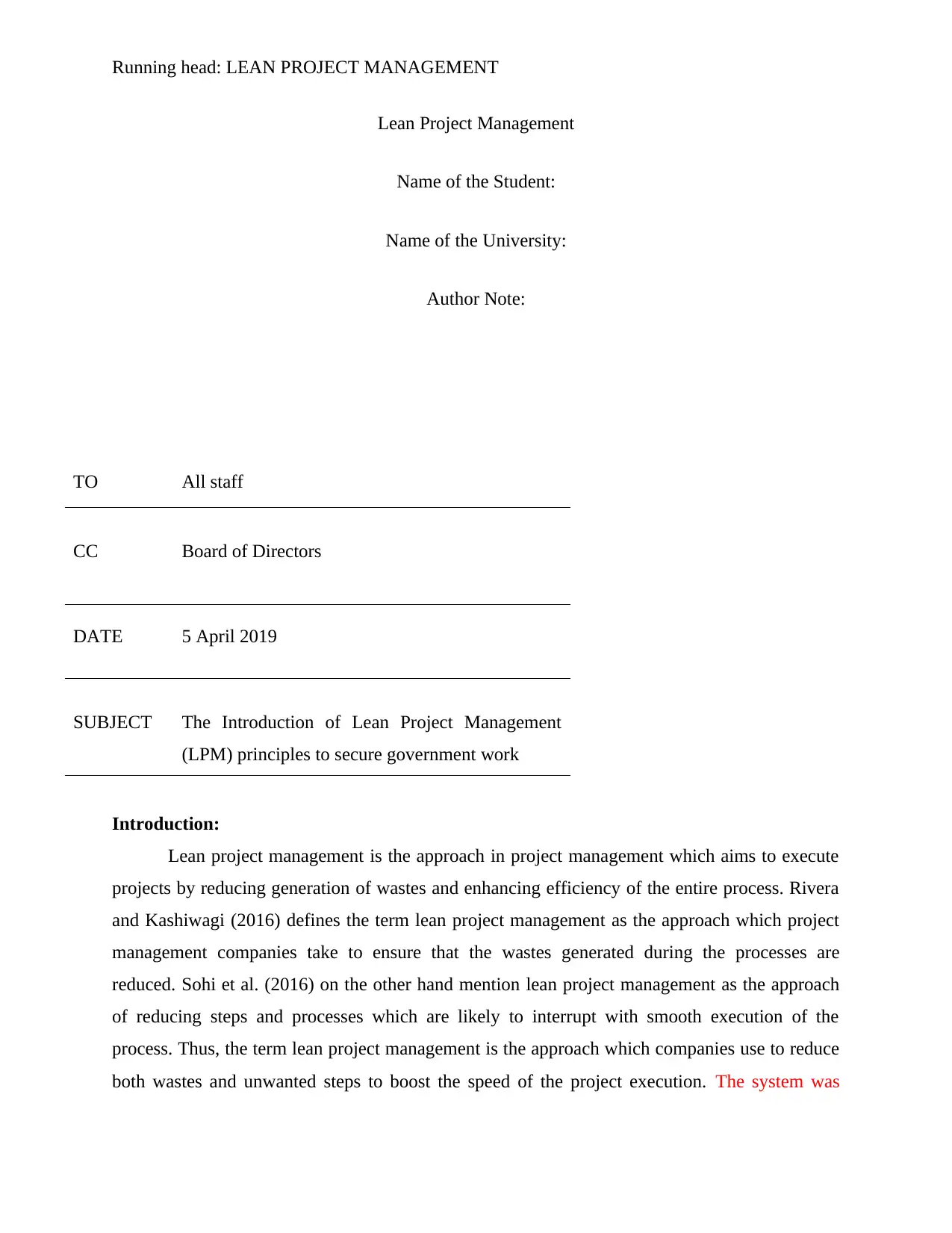
Running head: LEAN PROJECT MANAGEMENT
Lean Project Management
Name of the Student:
Name of the University:
Author Note:
Introduction:
Lean project management is the approach in project management which aims to execute
projects by reducing generation of wastes and enhancing efficiency of the entire process. Rivera
and Kashiwagi (2016) defines the term lean project management as the approach which project
management companies take to ensure that the wastes generated during the processes are
reduced. Sohi et al. (2016) on the other hand mention lean project management as the approach
of reducing steps and processes which are likely to interrupt with smooth execution of the
process. Thus, the term lean project management is the approach which companies use to reduce
both wastes and unwanted steps to boost the speed of the project execution. The system was
TO All staff
CC Board of Directors
DATE 5 April 2019
SUBJECT The Introduction of Lean Project Management
(LPM) principles to secure government work
Lean Project Management
Name of the Student:
Name of the University:
Author Note:
Introduction:
Lean project management is the approach in project management which aims to execute
projects by reducing generation of wastes and enhancing efficiency of the entire process. Rivera
and Kashiwagi (2016) defines the term lean project management as the approach which project
management companies take to ensure that the wastes generated during the processes are
reduced. Sohi et al. (2016) on the other hand mention lean project management as the approach
of reducing steps and processes which are likely to interrupt with smooth execution of the
process. Thus, the term lean project management is the approach which companies use to reduce
both wastes and unwanted steps to boost the speed of the project execution. The system was
TO All staff
CC Board of Directors
DATE 5 April 2019
SUBJECT The Introduction of Lean Project Management
(LPM) principles to secure government work
Paraphrase This Document
Need a fresh take? Get an instant paraphrase of this document with our AI Paraphraser
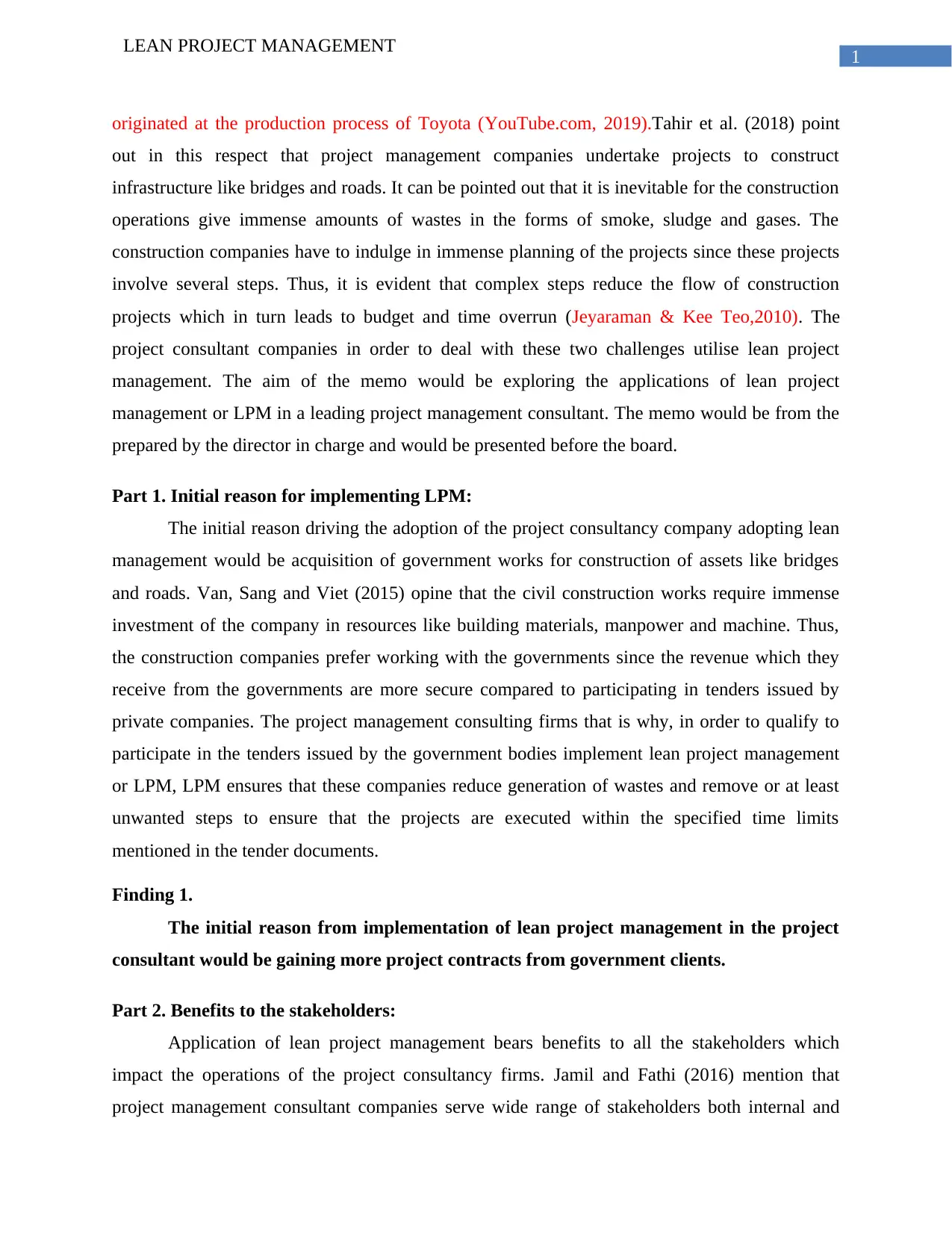
1
LEAN PROJECT MANAGEMENT
originated at the production process of Toyota (YouTube.com, 2019).Tahir et al. (2018) point
out in this respect that project management companies undertake projects to construct
infrastructure like bridges and roads. It can be pointed out that it is inevitable for the construction
operations give immense amounts of wastes in the forms of smoke, sludge and gases. The
construction companies have to indulge in immense planning of the projects since these projects
involve several steps. Thus, it is evident that complex steps reduce the flow of construction
projects which in turn leads to budget and time overrun (Jeyaraman & Kee Teo,2010). The
project consultant companies in order to deal with these two challenges utilise lean project
management. The aim of the memo would be exploring the applications of lean project
management or LPM in a leading project management consultant. The memo would be from the
prepared by the director in charge and would be presented before the board.
Part 1. Initial reason for implementing LPM:
The initial reason driving the adoption of the project consultancy company adopting lean
management would be acquisition of government works for construction of assets like bridges
and roads. Van, Sang and Viet (2015) opine that the civil construction works require immense
investment of the company in resources like building materials, manpower and machine. Thus,
the construction companies prefer working with the governments since the revenue which they
receive from the governments are more secure compared to participating in tenders issued by
private companies. The project management consulting firms that is why, in order to qualify to
participate in the tenders issued by the government bodies implement lean project management
or LPM, LPM ensures that these companies reduce generation of wastes and remove or at least
unwanted steps to ensure that the projects are executed within the specified time limits
mentioned in the tender documents.
Finding 1.
The initial reason from implementation of lean project management in the project
consultant would be gaining more project contracts from government clients.
Part 2. Benefits to the stakeholders:
Application of lean project management bears benefits to all the stakeholders which
impact the operations of the project consultancy firms. Jamil and Fathi (2016) mention that
project management consultant companies serve wide range of stakeholders both internal and
LEAN PROJECT MANAGEMENT
originated at the production process of Toyota (YouTube.com, 2019).Tahir et al. (2018) point
out in this respect that project management companies undertake projects to construct
infrastructure like bridges and roads. It can be pointed out that it is inevitable for the construction
operations give immense amounts of wastes in the forms of smoke, sludge and gases. The
construction companies have to indulge in immense planning of the projects since these projects
involve several steps. Thus, it is evident that complex steps reduce the flow of construction
projects which in turn leads to budget and time overrun (Jeyaraman & Kee Teo,2010). The
project consultant companies in order to deal with these two challenges utilise lean project
management. The aim of the memo would be exploring the applications of lean project
management or LPM in a leading project management consultant. The memo would be from the
prepared by the director in charge and would be presented before the board.
Part 1. Initial reason for implementing LPM:
The initial reason driving the adoption of the project consultancy company adopting lean
management would be acquisition of government works for construction of assets like bridges
and roads. Van, Sang and Viet (2015) opine that the civil construction works require immense
investment of the company in resources like building materials, manpower and machine. Thus,
the construction companies prefer working with the governments since the revenue which they
receive from the governments are more secure compared to participating in tenders issued by
private companies. The project management consulting firms that is why, in order to qualify to
participate in the tenders issued by the government bodies implement lean project management
or LPM, LPM ensures that these companies reduce generation of wastes and remove or at least
unwanted steps to ensure that the projects are executed within the specified time limits
mentioned in the tender documents.
Finding 1.
The initial reason from implementation of lean project management in the project
consultant would be gaining more project contracts from government clients.
Part 2. Benefits to the stakeholders:
Application of lean project management bears benefits to all the stakeholders which
impact the operations of the project consultancy firms. Jamil and Fathi (2016) mention that
project management consultant companies serve wide range of stakeholders both internal and
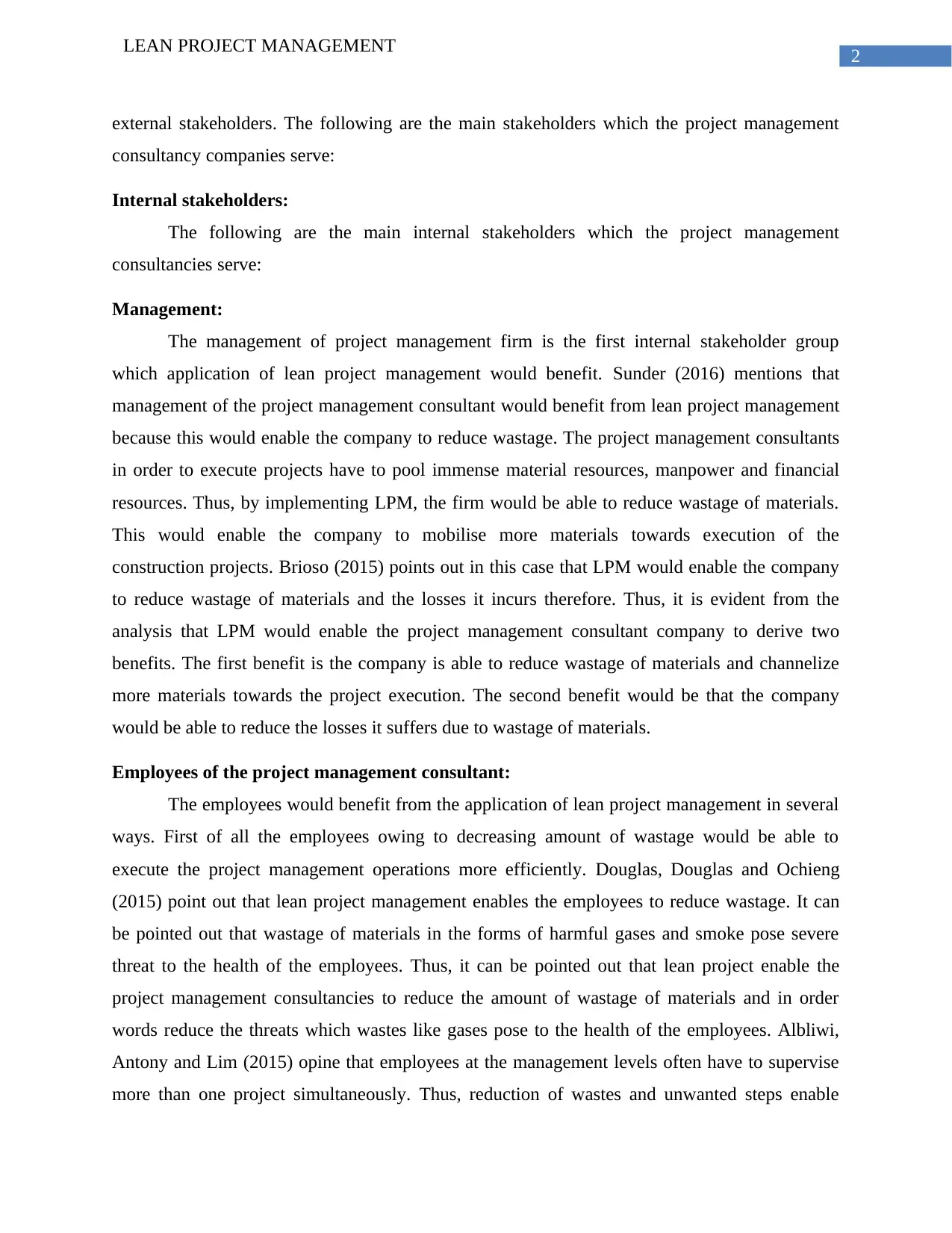
2
LEAN PROJECT MANAGEMENT
external stakeholders. The following are the main stakeholders which the project management
consultancy companies serve:
Internal stakeholders:
The following are the main internal stakeholders which the project management
consultancies serve:
Management:
The management of project management firm is the first internal stakeholder group
which application of lean project management would benefit. Sunder (2016) mentions that
management of the project management consultant would benefit from lean project management
because this would enable the company to reduce wastage. The project management consultants
in order to execute projects have to pool immense material resources, manpower and financial
resources. Thus, by implementing LPM, the firm would be able to reduce wastage of materials.
This would enable the company to mobilise more materials towards execution of the
construction projects. Brioso (2015) points out in this case that LPM would enable the company
to reduce wastage of materials and the losses it incurs therefore. Thus, it is evident from the
analysis that LPM would enable the project management consultant company to derive two
benefits. The first benefit is the company is able to reduce wastage of materials and channelize
more materials towards the project execution. The second benefit would be that the company
would be able to reduce the losses it suffers due to wastage of materials.
Employees of the project management consultant:
The employees would benefit from the application of lean project management in several
ways. First of all the employees owing to decreasing amount of wastage would be able to
execute the project management operations more efficiently. Douglas, Douglas and Ochieng
(2015) point out that lean project management enables the employees to reduce wastage. It can
be pointed out that wastage of materials in the forms of harmful gases and smoke pose severe
threat to the health of the employees. Thus, it can be pointed out that lean project enable the
project management consultancies to reduce the amount of wastage of materials and in order
words reduce the threats which wastes like gases pose to the health of the employees. Albliwi,
Antony and Lim (2015) opine that employees at the management levels often have to supervise
more than one project simultaneously. Thus, reduction of wastes and unwanted steps enable
LEAN PROJECT MANAGEMENT
external stakeholders. The following are the main stakeholders which the project management
consultancy companies serve:
Internal stakeholders:
The following are the main internal stakeholders which the project management
consultancies serve:
Management:
The management of project management firm is the first internal stakeholder group
which application of lean project management would benefit. Sunder (2016) mentions that
management of the project management consultant would benefit from lean project management
because this would enable the company to reduce wastage. The project management consultants
in order to execute projects have to pool immense material resources, manpower and financial
resources. Thus, by implementing LPM, the firm would be able to reduce wastage of materials.
This would enable the company to mobilise more materials towards execution of the
construction projects. Brioso (2015) points out in this case that LPM would enable the company
to reduce wastage of materials and the losses it incurs therefore. Thus, it is evident from the
analysis that LPM would enable the project management consultant company to derive two
benefits. The first benefit is the company is able to reduce wastage of materials and channelize
more materials towards the project execution. The second benefit would be that the company
would be able to reduce the losses it suffers due to wastage of materials.
Employees of the project management consultant:
The employees would benefit from the application of lean project management in several
ways. First of all the employees owing to decreasing amount of wastage would be able to
execute the project management operations more efficiently. Douglas, Douglas and Ochieng
(2015) point out that lean project management enables the employees to reduce wastage. It can
be pointed out that wastage of materials in the forms of harmful gases and smoke pose severe
threat to the health of the employees. Thus, it can be pointed out that lean project enable the
project management consultancies to reduce the amount of wastage of materials and in order
words reduce the threats which wastes like gases pose to the health of the employees. Albliwi,
Antony and Lim (2015) opine that employees at the management levels often have to supervise
more than one project simultaneously. Thus, reduction of wastes and unwanted steps enable
⊘ This is a preview!⊘
Do you want full access?
Subscribe today to unlock all pages.

Trusted by 1+ million students worldwide
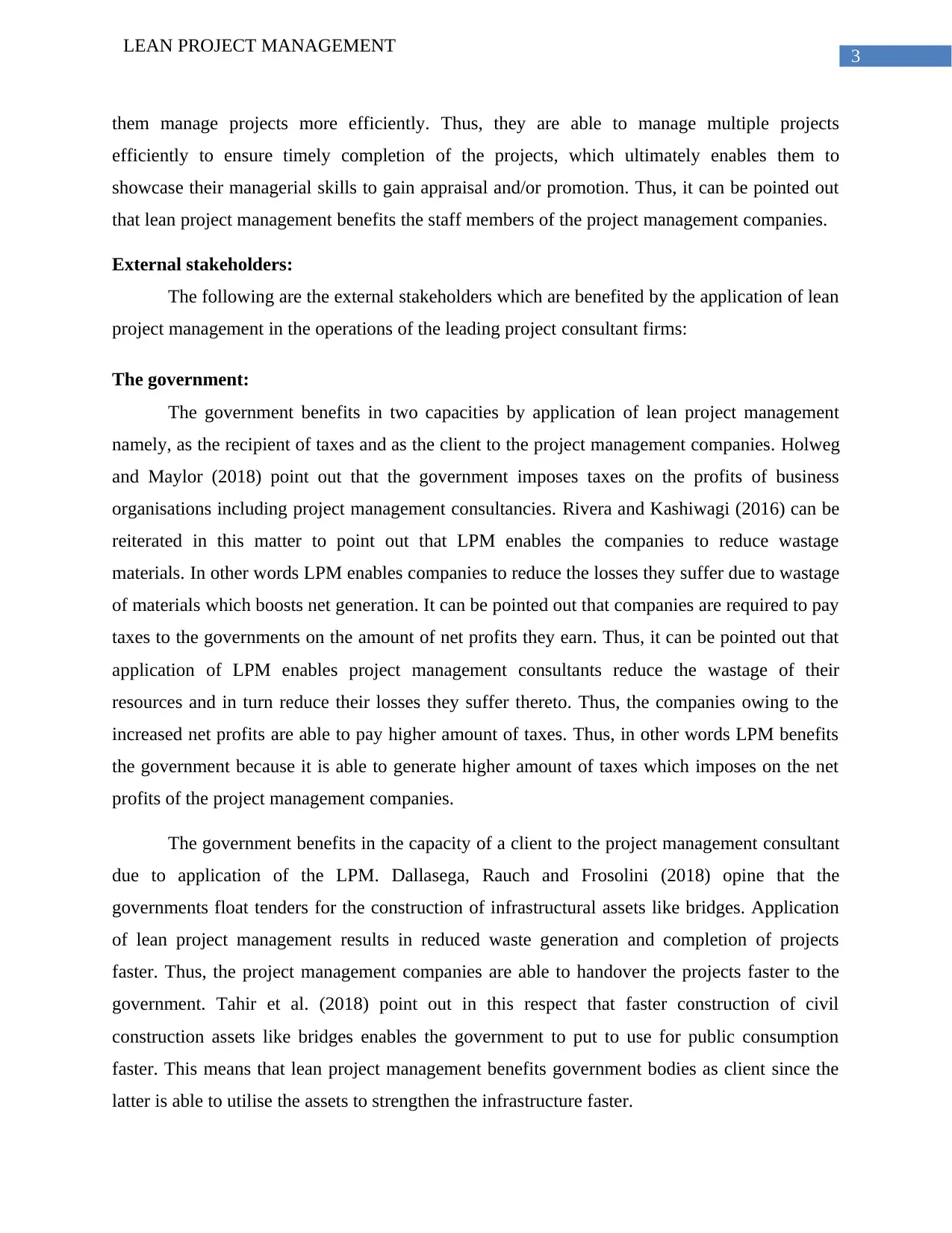
3
LEAN PROJECT MANAGEMENT
them manage projects more efficiently. Thus, they are able to manage multiple projects
efficiently to ensure timely completion of the projects, which ultimately enables them to
showcase their managerial skills to gain appraisal and/or promotion. Thus, it can be pointed out
that lean project management benefits the staff members of the project management companies.
External stakeholders:
The following are the external stakeholders which are benefited by the application of lean
project management in the operations of the leading project consultant firms:
The government:
The government benefits in two capacities by application of lean project management
namely, as the recipient of taxes and as the client to the project management companies. Holweg
and Maylor (2018) point out that the government imposes taxes on the profits of business
organisations including project management consultancies. Rivera and Kashiwagi (2016) can be
reiterated in this matter to point out that LPM enables the companies to reduce wastage
materials. In other words LPM enables companies to reduce the losses they suffer due to wastage
of materials which boosts net generation. It can be pointed out that companies are required to pay
taxes to the governments on the amount of net profits they earn. Thus, it can be pointed out that
application of LPM enables project management consultants reduce the wastage of their
resources and in turn reduce their losses they suffer thereto. Thus, the companies owing to the
increased net profits are able to pay higher amount of taxes. Thus, in other words LPM benefits
the government because it is able to generate higher amount of taxes which imposes on the net
profits of the project management companies.
The government benefits in the capacity of a client to the project management consultant
due to application of the LPM. Dallasega, Rauch and Frosolini (2018) opine that the
governments float tenders for the construction of infrastructural assets like bridges. Application
of lean project management results in reduced waste generation and completion of projects
faster. Thus, the project management companies are able to handover the projects faster to the
government. Tahir et al. (2018) point out in this respect that faster construction of civil
construction assets like bridges enables the government to put to use for public consumption
faster. This means that lean project management benefits government bodies as client since the
latter is able to utilise the assets to strengthen the infrastructure faster.
LEAN PROJECT MANAGEMENT
them manage projects more efficiently. Thus, they are able to manage multiple projects
efficiently to ensure timely completion of the projects, which ultimately enables them to
showcase their managerial skills to gain appraisal and/or promotion. Thus, it can be pointed out
that lean project management benefits the staff members of the project management companies.
External stakeholders:
The following are the external stakeholders which are benefited by the application of lean
project management in the operations of the leading project consultant firms:
The government:
The government benefits in two capacities by application of lean project management
namely, as the recipient of taxes and as the client to the project management companies. Holweg
and Maylor (2018) point out that the government imposes taxes on the profits of business
organisations including project management consultancies. Rivera and Kashiwagi (2016) can be
reiterated in this matter to point out that LPM enables the companies to reduce wastage
materials. In other words LPM enables companies to reduce the losses they suffer due to wastage
of materials which boosts net generation. It can be pointed out that companies are required to pay
taxes to the governments on the amount of net profits they earn. Thus, it can be pointed out that
application of LPM enables project management consultants reduce the wastage of their
resources and in turn reduce their losses they suffer thereto. Thus, the companies owing to the
increased net profits are able to pay higher amount of taxes. Thus, in other words LPM benefits
the government because it is able to generate higher amount of taxes which imposes on the net
profits of the project management companies.
The government benefits in the capacity of a client to the project management consultant
due to application of the LPM. Dallasega, Rauch and Frosolini (2018) opine that the
governments float tenders for the construction of infrastructural assets like bridges. Application
of lean project management results in reduced waste generation and completion of projects
faster. Thus, the project management companies are able to handover the projects faster to the
government. Tahir et al. (2018) point out in this respect that faster construction of civil
construction assets like bridges enables the government to put to use for public consumption
faster. This means that lean project management benefits government bodies as client since the
latter is able to utilise the assets to strengthen the infrastructure faster.
Paraphrase This Document
Need a fresh take? Get an instant paraphrase of this document with our AI Paraphraser
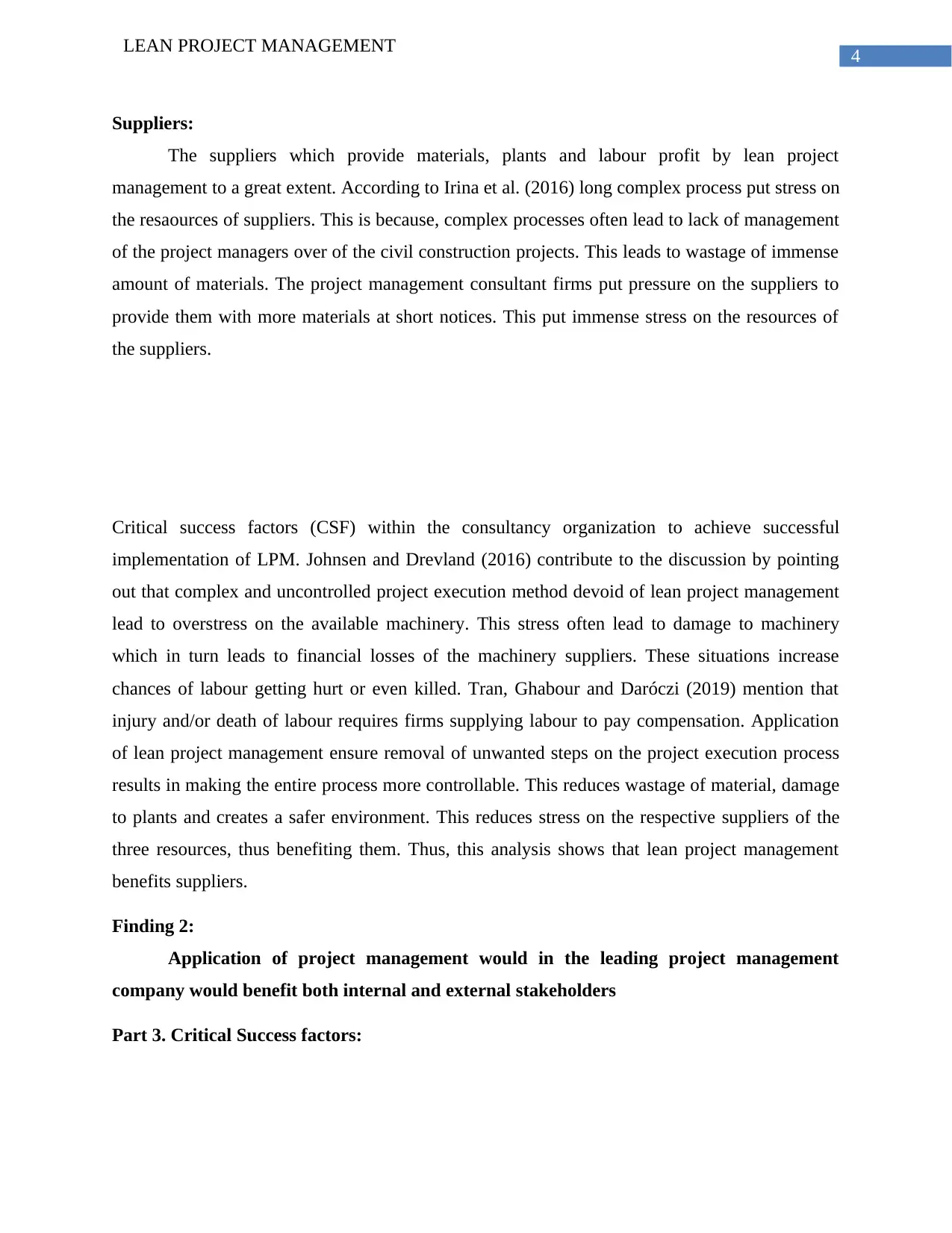
4
LEAN PROJECT MANAGEMENT
Suppliers:
The suppliers which provide materials, plants and labour profit by lean project
management to a great extent. According to Irina et al. (2016) long complex process put stress on
the resaources of suppliers. This is because, complex processes often lead to lack of management
of the project managers over of the civil construction projects. This leads to wastage of immense
amount of materials. The project management consultant firms put pressure on the suppliers to
provide them with more materials at short notices. This put immense stress on the resources of
the suppliers.
Critical success factors (CSF) within the consultancy organization to achieve successful
implementation of LPM. Johnsen and Drevland (2016) contribute to the discussion by pointing
out that complex and uncontrolled project execution method devoid of lean project management
lead to overstress on the available machinery. This stress often lead to damage to machinery
which in turn leads to financial losses of the machinery suppliers. These situations increase
chances of labour getting hurt or even killed. Tran, Ghabour and Daróczi (2019) mention that
injury and/or death of labour requires firms supplying labour to pay compensation. Application
of lean project management ensure removal of unwanted steps on the project execution process
results in making the entire process more controllable. This reduces wastage of material, damage
to plants and creates a safer environment. This reduces stress on the respective suppliers of the
three resources, thus benefiting them. Thus, this analysis shows that lean project management
benefits suppliers.
Finding 2:
Application of project management would in the leading project management
company would benefit both internal and external stakeholders
Part 3. Critical Success factors:
LEAN PROJECT MANAGEMENT
Suppliers:
The suppliers which provide materials, plants and labour profit by lean project
management to a great extent. According to Irina et al. (2016) long complex process put stress on
the resaources of suppliers. This is because, complex processes often lead to lack of management
of the project managers over of the civil construction projects. This leads to wastage of immense
amount of materials. The project management consultant firms put pressure on the suppliers to
provide them with more materials at short notices. This put immense stress on the resources of
the suppliers.
Critical success factors (CSF) within the consultancy organization to achieve successful
implementation of LPM. Johnsen and Drevland (2016) contribute to the discussion by pointing
out that complex and uncontrolled project execution method devoid of lean project management
lead to overstress on the available machinery. This stress often lead to damage to machinery
which in turn leads to financial losses of the machinery suppliers. These situations increase
chances of labour getting hurt or even killed. Tran, Ghabour and Daróczi (2019) mention that
injury and/or death of labour requires firms supplying labour to pay compensation. Application
of lean project management ensure removal of unwanted steps on the project execution process
results in making the entire process more controllable. This reduces wastage of material, damage
to plants and creates a safer environment. This reduces stress on the respective suppliers of the
three resources, thus benefiting them. Thus, this analysis shows that lean project management
benefits suppliers.
Finding 2:
Application of project management would in the leading project management
company would benefit both internal and external stakeholders
Part 3. Critical Success factors:
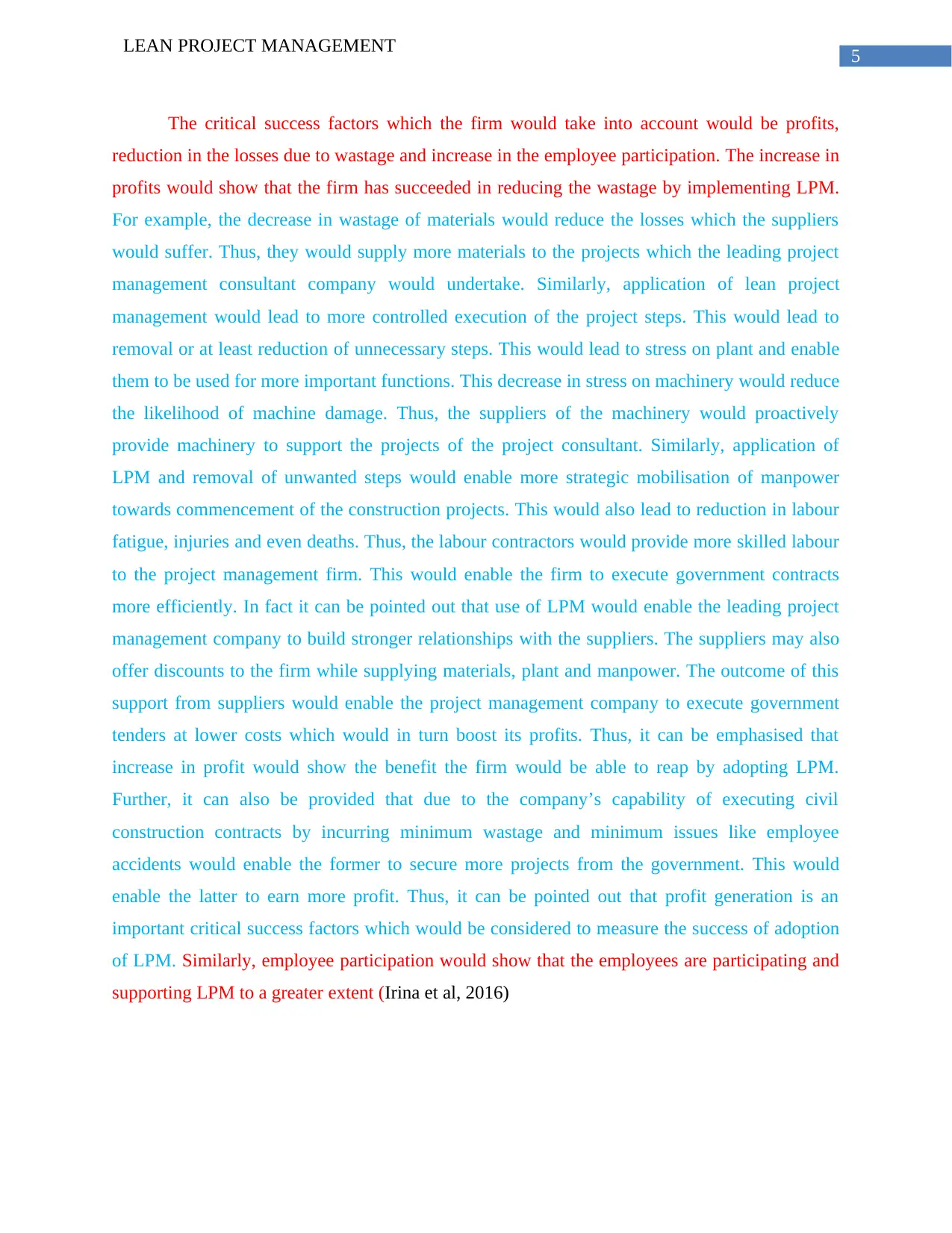
5
LEAN PROJECT MANAGEMENT
The critical success factors which the firm would take into account would be profits,
reduction in the losses due to wastage and increase in the employee participation. The increase in
profits would show that the firm has succeeded in reducing the wastage by implementing LPM.
For example, the decrease in wastage of materials would reduce the losses which the suppliers
would suffer. Thus, they would supply more materials to the projects which the leading project
management consultant company would undertake. Similarly, application of lean project
management would lead to more controlled execution of the project steps. This would lead to
removal or at least reduction of unnecessary steps. This would lead to stress on plant and enable
them to be used for more important functions. This decrease in stress on machinery would reduce
the likelihood of machine damage. Thus, the suppliers of the machinery would proactively
provide machinery to support the projects of the project consultant. Similarly, application of
LPM and removal of unwanted steps would enable more strategic mobilisation of manpower
towards commencement of the construction projects. This would also lead to reduction in labour
fatigue, injuries and even deaths. Thus, the labour contractors would provide more skilled labour
to the project management firm. This would enable the firm to execute government contracts
more efficiently. In fact it can be pointed out that use of LPM would enable the leading project
management company to build stronger relationships with the suppliers. The suppliers may also
offer discounts to the firm while supplying materials, plant and manpower. The outcome of this
support from suppliers would enable the project management company to execute government
tenders at lower costs which would in turn boost its profits. Thus, it can be emphasised that
increase in profit would show the benefit the firm would be able to reap by adopting LPM.
Further, it can also be provided that due to the company’s capability of executing civil
construction contracts by incurring minimum wastage and minimum issues like employee
accidents would enable the former to secure more projects from the government. This would
enable the latter to earn more profit. Thus, it can be pointed out that profit generation is an
important critical success factors which would be considered to measure the success of adoption
of LPM. Similarly, employee participation would show that the employees are participating and
supporting LPM to a greater extent (Irina et al, 2016)
LEAN PROJECT MANAGEMENT
The critical success factors which the firm would take into account would be profits,
reduction in the losses due to wastage and increase in the employee participation. The increase in
profits would show that the firm has succeeded in reducing the wastage by implementing LPM.
For example, the decrease in wastage of materials would reduce the losses which the suppliers
would suffer. Thus, they would supply more materials to the projects which the leading project
management consultant company would undertake. Similarly, application of lean project
management would lead to more controlled execution of the project steps. This would lead to
removal or at least reduction of unnecessary steps. This would lead to stress on plant and enable
them to be used for more important functions. This decrease in stress on machinery would reduce
the likelihood of machine damage. Thus, the suppliers of the machinery would proactively
provide machinery to support the projects of the project consultant. Similarly, application of
LPM and removal of unwanted steps would enable more strategic mobilisation of manpower
towards commencement of the construction projects. This would also lead to reduction in labour
fatigue, injuries and even deaths. Thus, the labour contractors would provide more skilled labour
to the project management firm. This would enable the firm to execute government contracts
more efficiently. In fact it can be pointed out that use of LPM would enable the leading project
management company to build stronger relationships with the suppliers. The suppliers may also
offer discounts to the firm while supplying materials, plant and manpower. The outcome of this
support from suppliers would enable the project management company to execute government
tenders at lower costs which would in turn boost its profits. Thus, it can be emphasised that
increase in profit would show the benefit the firm would be able to reap by adopting LPM.
Further, it can also be provided that due to the company’s capability of executing civil
construction contracts by incurring minimum wastage and minimum issues like employee
accidents would enable the former to secure more projects from the government. This would
enable the latter to earn more profit. Thus, it can be pointed out that profit generation is an
important critical success factors which would be considered to measure the success of adoption
of LPM. Similarly, employee participation would show that the employees are participating and
supporting LPM to a greater extent (Irina et al, 2016)
⊘ This is a preview!⊘
Do you want full access?
Subscribe today to unlock all pages.

Trusted by 1+ million students worldwide
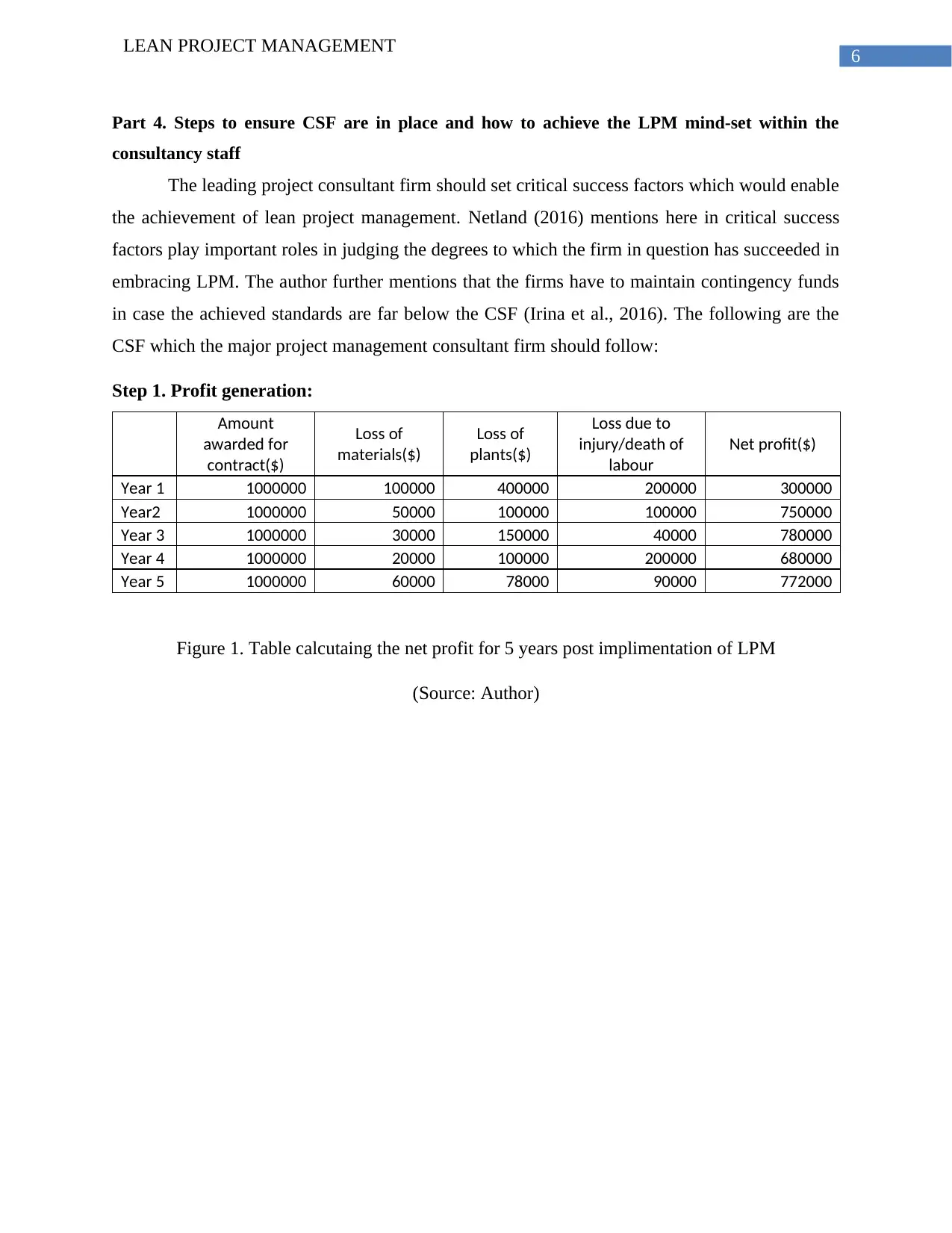
6
LEAN PROJECT MANAGEMENT
Part 4. Steps to ensure CSF are in place and how to achieve the LPM mind-set within the
consultancy staff
The leading project consultant firm should set critical success factors which would enable
the achievement of lean project management. Netland (2016) mentions here in critical success
factors play important roles in judging the degrees to which the firm in question has succeeded in
embracing LPM. The author further mentions that the firms have to maintain contingency funds
in case the achieved standards are far below the CSF (Irina et al., 2016). The following are the
CSF which the major project management consultant firm should follow:
Step 1. Profit generation:
Amount
awarded for
contract($)
Loss of
materials($)
Loss of
plants($)
Loss due to
injury/death of
labour
Net profit($)
Year 1 1000000 100000 400000 200000 300000
Year2 1000000 50000 100000 100000 750000
Year 3 1000000 30000 150000 40000 780000
Year 4 1000000 20000 100000 200000 680000
Year 5 1000000 60000 78000 90000 772000
Figure 1. Table calcutaing the net profit for 5 years post implimentation of LPM
(Source: Author)
LEAN PROJECT MANAGEMENT
Part 4. Steps to ensure CSF are in place and how to achieve the LPM mind-set within the
consultancy staff
The leading project consultant firm should set critical success factors which would enable
the achievement of lean project management. Netland (2016) mentions here in critical success
factors play important roles in judging the degrees to which the firm in question has succeeded in
embracing LPM. The author further mentions that the firms have to maintain contingency funds
in case the achieved standards are far below the CSF (Irina et al., 2016). The following are the
CSF which the major project management consultant firm should follow:
Step 1. Profit generation:
Amount
awarded for
contract($)
Loss of
materials($)
Loss of
plants($)
Loss due to
injury/death of
labour
Net profit($)
Year 1 1000000 100000 400000 200000 300000
Year2 1000000 50000 100000 100000 750000
Year 3 1000000 30000 150000 40000 780000
Year 4 1000000 20000 100000 200000 680000
Year 5 1000000 60000 78000 90000 772000
Figure 1. Table calcutaing the net profit for 5 years post implimentation of LPM
(Source: Author)
Paraphrase This Document
Need a fresh take? Get an instant paraphrase of this document with our AI Paraphraser
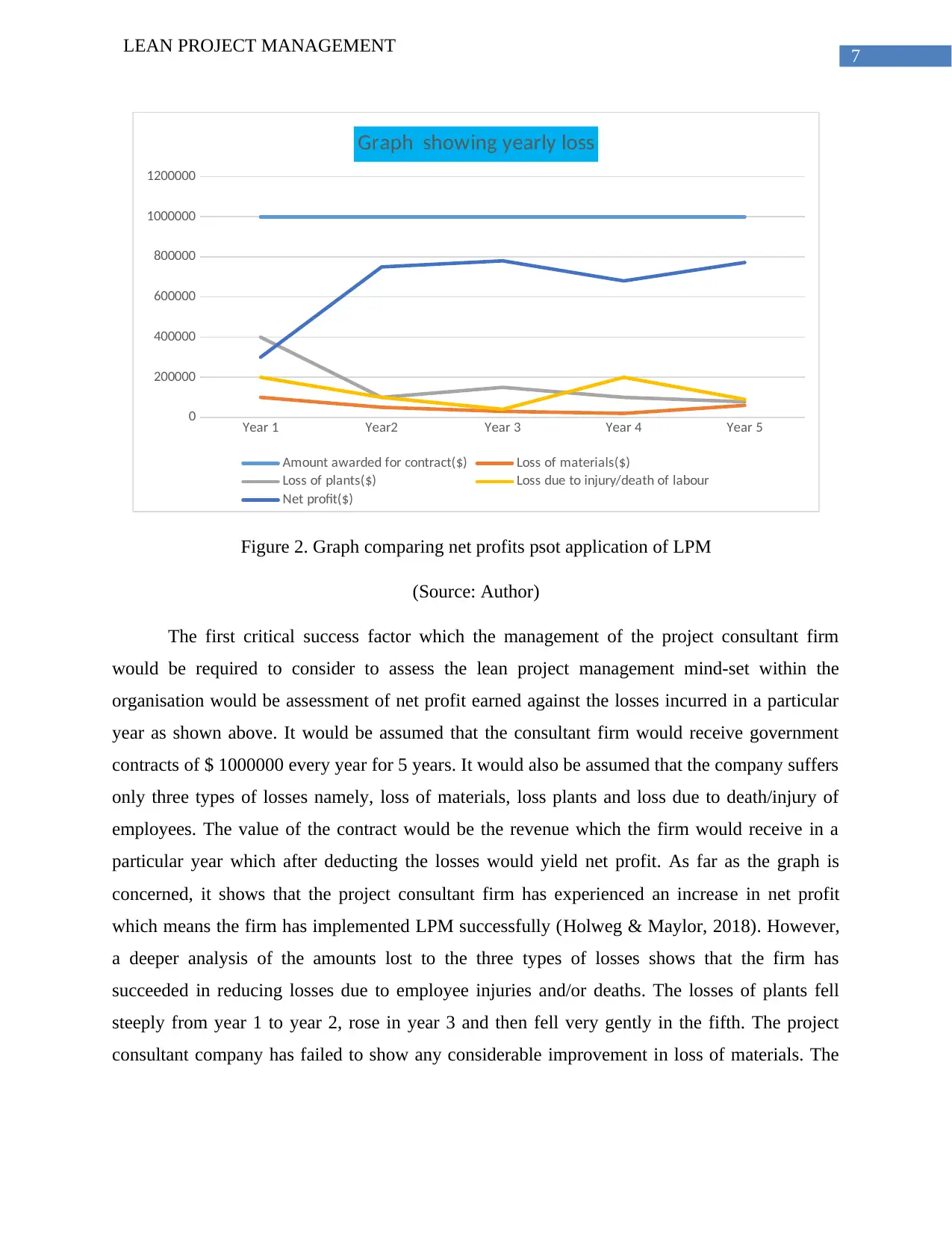
7
LEAN PROJECT MANAGEMENT
Year 1 Year2 Year 3 Year 4 Year 5
0
200000
400000
600000
800000
1000000
1200000
Graph showing yearly loss
Amount awarded for contract($) Loss of materials($)
Loss of plants($) Loss due to injury/death of labour
Net profit($)
Figure 2. Graph comparing net profits psot application of LPM
(Source: Author)
The first critical success factor which the management of the project consultant firm
would be required to consider to assess the lean project management mind-set within the
organisation would be assessment of net profit earned against the losses incurred in a particular
year as shown above. It would be assumed that the consultant firm would receive government
contracts of $ 1000000 every year for 5 years. It would also be assumed that the company suffers
only three types of losses namely, loss of materials, loss plants and loss due to death/injury of
employees. The value of the contract would be the revenue which the firm would receive in a
particular year which after deducting the losses would yield net profit. As far as the graph is
concerned, it shows that the project consultant firm has experienced an increase in net profit
which means the firm has implemented LPM successfully (Holweg & Maylor, 2018). However,
a deeper analysis of the amounts lost to the three types of losses shows that the firm has
succeeded in reducing losses due to employee injuries and/or deaths. The losses of plants fell
steeply from year 1 to year 2, rose in year 3 and then fell very gently in the fifth. The project
consultant company has failed to show any considerable improvement in loss of materials. The
LEAN PROJECT MANAGEMENT
Year 1 Year2 Year 3 Year 4 Year 5
0
200000
400000
600000
800000
1000000
1200000
Graph showing yearly loss
Amount awarded for contract($) Loss of materials($)
Loss of plants($) Loss due to injury/death of labour
Net profit($)
Figure 2. Graph comparing net profits psot application of LPM
(Source: Author)
The first critical success factor which the management of the project consultant firm
would be required to consider to assess the lean project management mind-set within the
organisation would be assessment of net profit earned against the losses incurred in a particular
year as shown above. It would be assumed that the consultant firm would receive government
contracts of $ 1000000 every year for 5 years. It would also be assumed that the company suffers
only three types of losses namely, loss of materials, loss plants and loss due to death/injury of
employees. The value of the contract would be the revenue which the firm would receive in a
particular year which after deducting the losses would yield net profit. As far as the graph is
concerned, it shows that the project consultant firm has experienced an increase in net profit
which means the firm has implemented LPM successfully (Holweg & Maylor, 2018). However,
a deeper analysis of the amounts lost to the three types of losses shows that the firm has
succeeded in reducing losses due to employee injuries and/or deaths. The losses of plants fell
steeply from year 1 to year 2, rose in year 3 and then fell very gently in the fifth. The project
consultant company has failed to show any considerable improvement in loss of materials. The
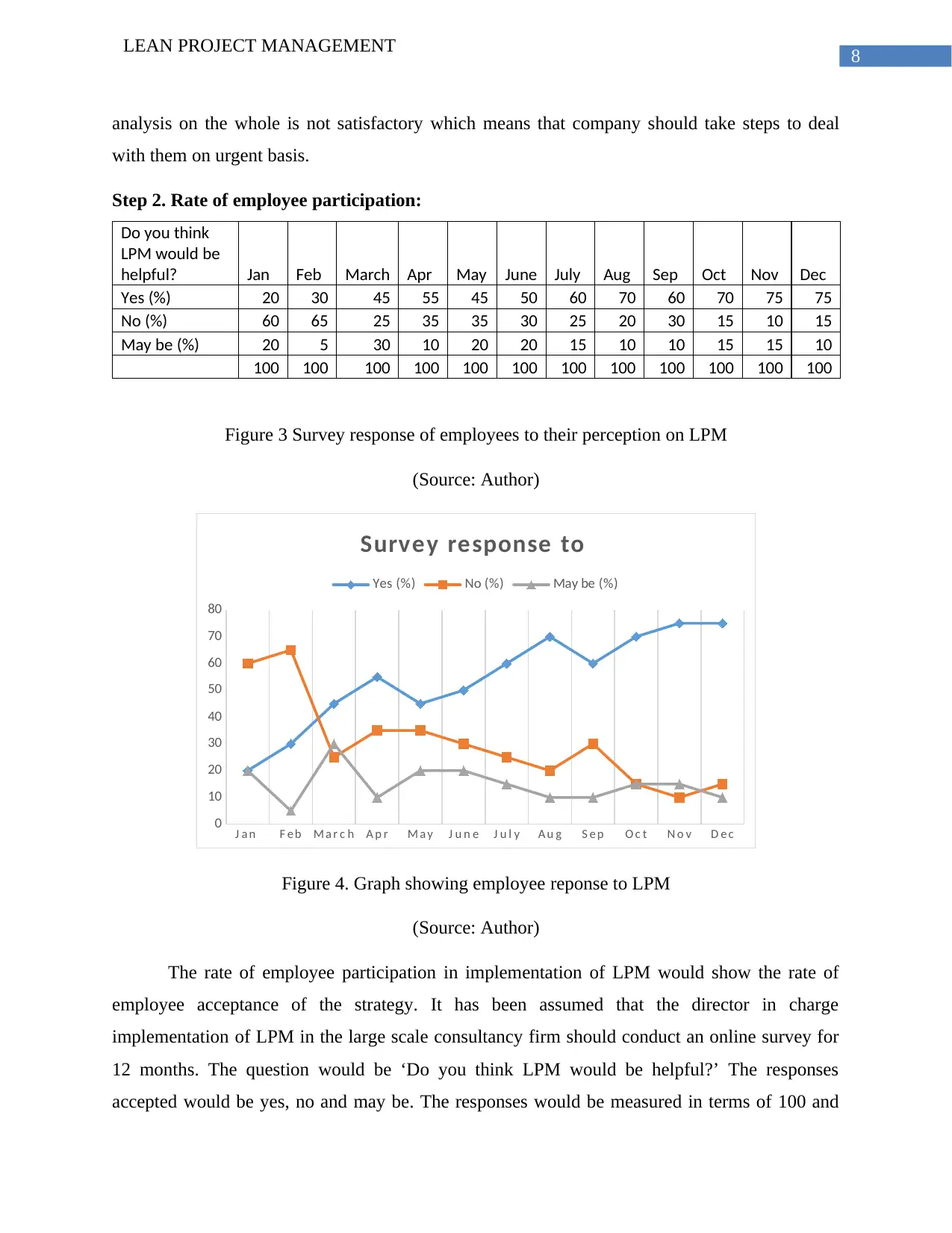
8
LEAN PROJECT MANAGEMENT
analysis on the whole is not satisfactory which means that company should take steps to deal
with them on urgent basis.
Step 2. Rate of employee participation:
Do you think
LPM would be
helpful? Jan Feb March Apr May June July Aug Sep Oct Nov Dec
Yes (%) 20 30 45 55 45 50 60 70 60 70 75 75
No (%) 60 65 25 35 35 30 25 20 30 15 10 15
May be (%) 20 5 30 10 20 20 15 10 10 15 15 10
100 100 100 100 100 100 100 100 100 100 100 100
Figure 3 Survey response of employees to their perception on LPM
(Source: Author)
J a n F e b M a r c h A p r M a y J u n e J u l y A u g S e p O c t N o v D e c
0
10
20
30
40
50
60
70
80
Survey response to
Yes (%) No (%) May be (%)
Figure 4. Graph showing employee reponse to LPM
(Source: Author)
The rate of employee participation in implementation of LPM would show the rate of
employee acceptance of the strategy. It has been assumed that the director in charge
implementation of LPM in the large scale consultancy firm should conduct an online survey for
12 months. The question would be ‘Do you think LPM would be helpful?’ The responses
accepted would be yes, no and may be. The responses would be measured in terms of 100 and
LEAN PROJECT MANAGEMENT
analysis on the whole is not satisfactory which means that company should take steps to deal
with them on urgent basis.
Step 2. Rate of employee participation:
Do you think
LPM would be
helpful? Jan Feb March Apr May June July Aug Sep Oct Nov Dec
Yes (%) 20 30 45 55 45 50 60 70 60 70 75 75
No (%) 60 65 25 35 35 30 25 20 30 15 10 15
May be (%) 20 5 30 10 20 20 15 10 10 15 15 10
100 100 100 100 100 100 100 100 100 100 100 100
Figure 3 Survey response of employees to their perception on LPM
(Source: Author)
J a n F e b M a r c h A p r M a y J u n e J u l y A u g S e p O c t N o v D e c
0
10
20
30
40
50
60
70
80
Survey response to
Yes (%) No (%) May be (%)
Figure 4. Graph showing employee reponse to LPM
(Source: Author)
The rate of employee participation in implementation of LPM would show the rate of
employee acceptance of the strategy. It has been assumed that the director in charge
implementation of LPM in the large scale consultancy firm should conduct an online survey for
12 months. The question would be ‘Do you think LPM would be helpful?’ The responses
accepted would be yes, no and may be. The responses would be measured in terms of 100 and
⊘ This is a preview!⊘
Do you want full access?
Subscribe today to unlock all pages.

Trusted by 1+ million students worldwide
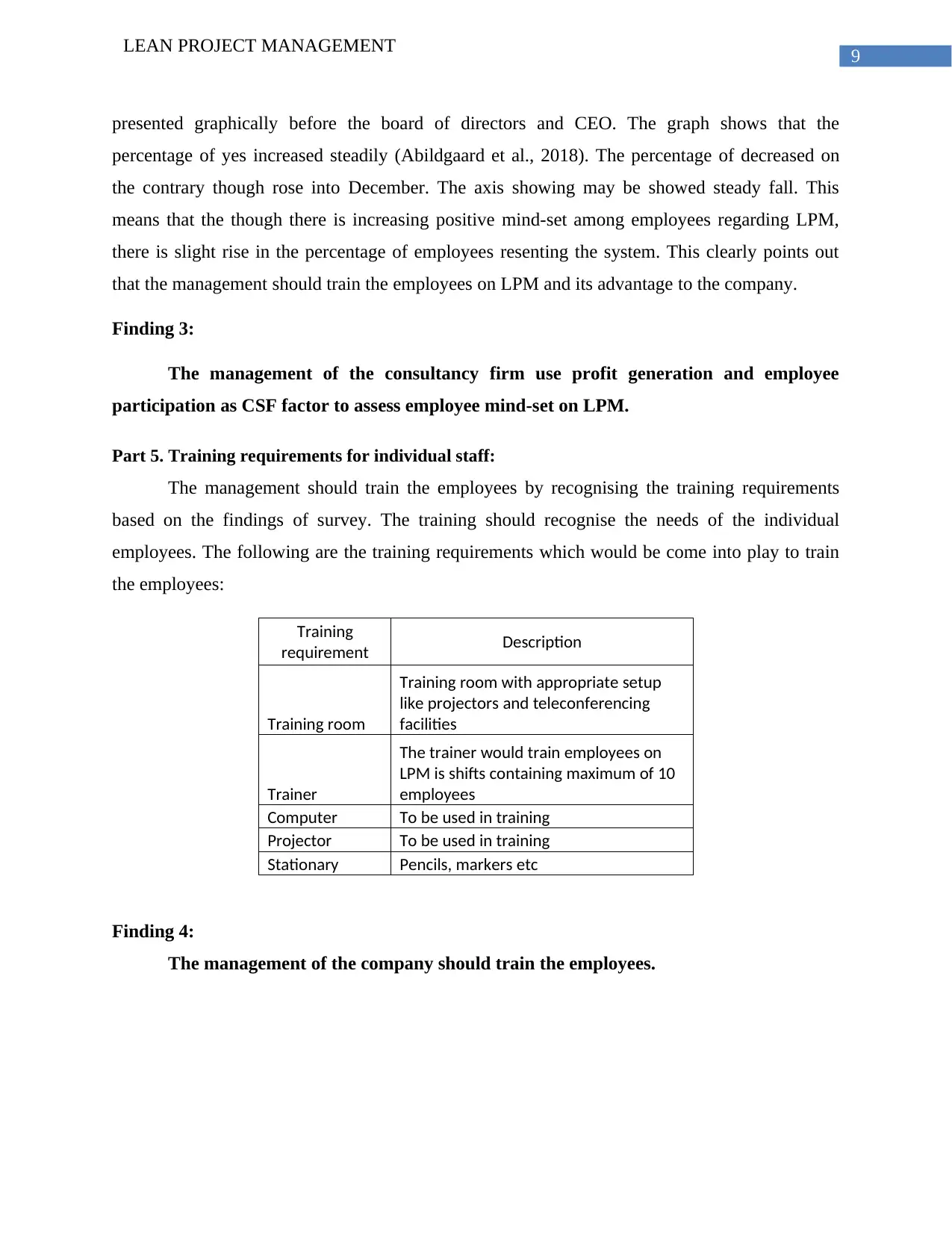
9
LEAN PROJECT MANAGEMENT
presented graphically before the board of directors and CEO. The graph shows that the
percentage of yes increased steadily (Abildgaard et al., 2018). The percentage of decreased on
the contrary though rose into December. The axis showing may be showed steady fall. This
means that the though there is increasing positive mind-set among employees regarding LPM,
there is slight rise in the percentage of employees resenting the system. This clearly points out
that the management should train the employees on LPM and its advantage to the company.
Finding 3:
The management of the consultancy firm use profit generation and employee
participation as CSF factor to assess employee mind-set on LPM.
Part 5. Training requirements for individual staff:
The management should train the employees by recognising the training requirements
based on the findings of survey. The training should recognise the needs of the individual
employees. The following are the training requirements which would be come into play to train
the employees:
Training
requirement Description
Training room
Training room with appropriate setup
like projectors and teleconferencing
facilities
Trainer
The trainer would train employees on
LPM is shifts containing maximum of 10
employees
Computer To be used in training
Projector To be used in training
Stationary Pencils, markers etc
Finding 4:
The management of the company should train the employees.
LEAN PROJECT MANAGEMENT
presented graphically before the board of directors and CEO. The graph shows that the
percentage of yes increased steadily (Abildgaard et al., 2018). The percentage of decreased on
the contrary though rose into December. The axis showing may be showed steady fall. This
means that the though there is increasing positive mind-set among employees regarding LPM,
there is slight rise in the percentage of employees resenting the system. This clearly points out
that the management should train the employees on LPM and its advantage to the company.
Finding 3:
The management of the consultancy firm use profit generation and employee
participation as CSF factor to assess employee mind-set on LPM.
Part 5. Training requirements for individual staff:
The management should train the employees by recognising the training requirements
based on the findings of survey. The training should recognise the needs of the individual
employees. The following are the training requirements which would be come into play to train
the employees:
Training
requirement Description
Training room
Training room with appropriate setup
like projectors and teleconferencing
facilities
Trainer
The trainer would train employees on
LPM is shifts containing maximum of 10
employees
Computer To be used in training
Projector To be used in training
Stationary Pencils, markers etc
Finding 4:
The management of the company should train the employees.
Paraphrase This Document
Need a fresh take? Get an instant paraphrase of this document with our AI Paraphraser
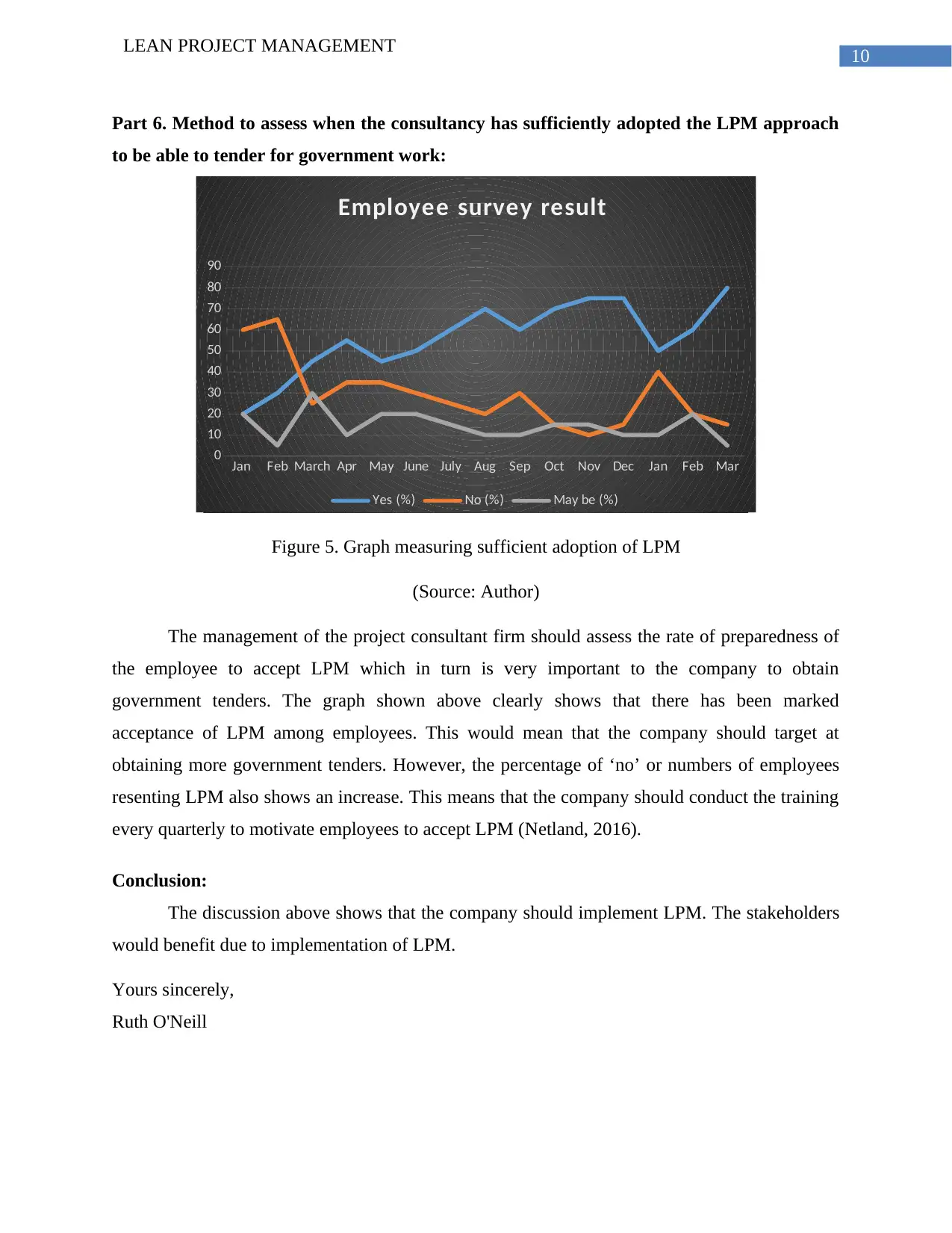
10
LEAN PROJECT MANAGEMENT
Part 6. Method to assess when the consultancy has sufficiently adopted the LPM approach
to be able to tender for government work:
Jan Feb March Apr May June July Aug Sep Oct Nov Dec Jan Feb Mar
0
10
20
30
40
50
60
70
80
90
Employee survey result
Yes (%) No (%) May be (%)
Figure 5. Graph measuring sufficient adoption of LPM
(Source: Author)
The management of the project consultant firm should assess the rate of preparedness of
the employee to accept LPM which in turn is very important to the company to obtain
government tenders. The graph shown above clearly shows that there has been marked
acceptance of LPM among employees. This would mean that the company should target at
obtaining more government tenders. However, the percentage of ‘no’ or numbers of employees
resenting LPM also shows an increase. This means that the company should conduct the training
every quarterly to motivate employees to accept LPM (Netland, 2016).
Conclusion:
The discussion above shows that the company should implement LPM. The stakeholders
would benefit due to implementation of LPM.
Yours sincerely,
Ruth O'Neill
LEAN PROJECT MANAGEMENT
Part 6. Method to assess when the consultancy has sufficiently adopted the LPM approach
to be able to tender for government work:
Jan Feb March Apr May June July Aug Sep Oct Nov Dec Jan Feb Mar
0
10
20
30
40
50
60
70
80
90
Employee survey result
Yes (%) No (%) May be (%)
Figure 5. Graph measuring sufficient adoption of LPM
(Source: Author)
The management of the project consultant firm should assess the rate of preparedness of
the employee to accept LPM which in turn is very important to the company to obtain
government tenders. The graph shown above clearly shows that there has been marked
acceptance of LPM among employees. This would mean that the company should target at
obtaining more government tenders. However, the percentage of ‘no’ or numbers of employees
resenting LPM also shows an increase. This means that the company should conduct the training
every quarterly to motivate employees to accept LPM (Netland, 2016).
Conclusion:
The discussion above shows that the company should implement LPM. The stakeholders
would benefit due to implementation of LPM.
Yours sincerely,
Ruth O'Neill
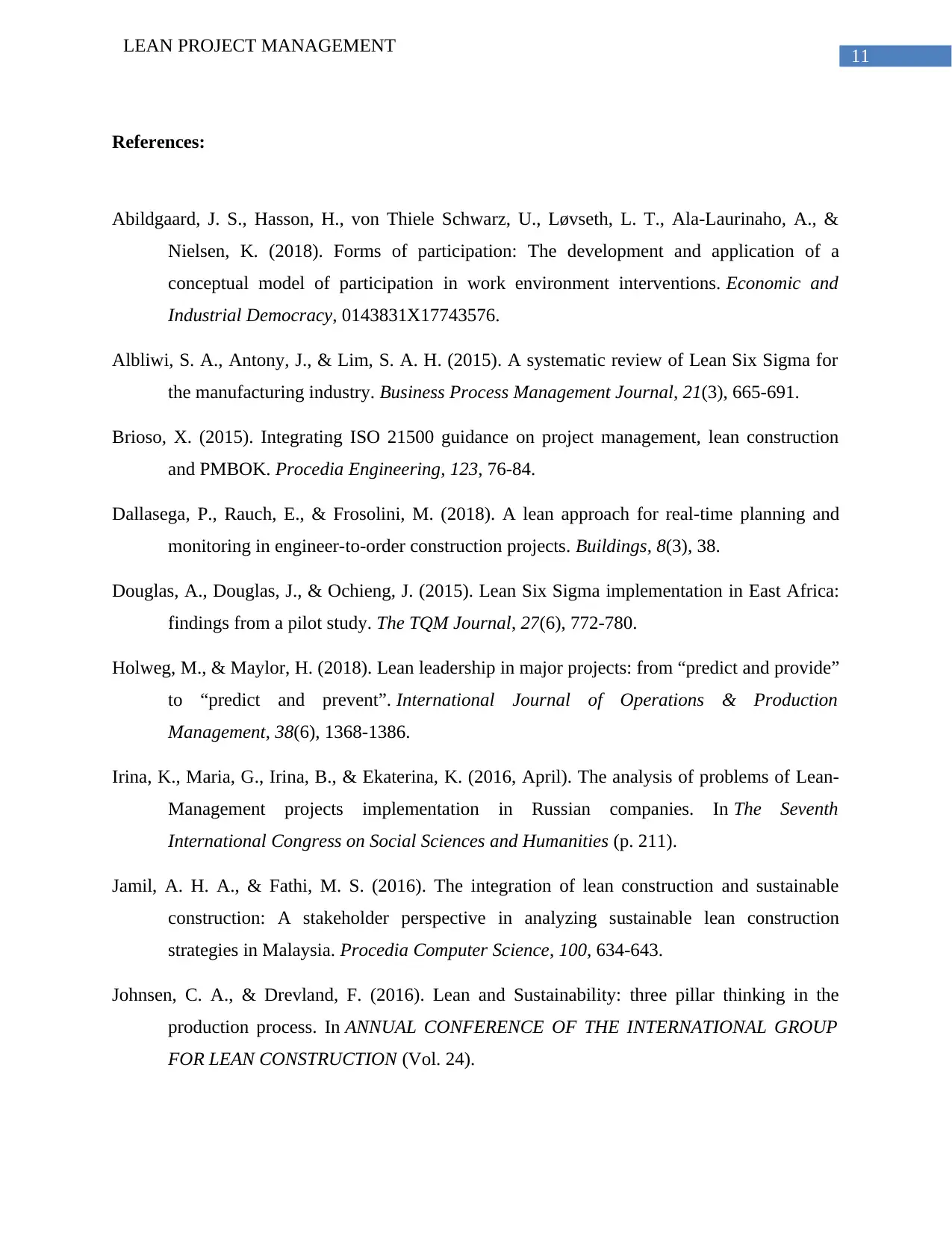
11
LEAN PROJECT MANAGEMENT
References:
Abildgaard, J. S., Hasson, H., von Thiele Schwarz, U., Løvseth, L. T., Ala-Laurinaho, A., &
Nielsen, K. (2018). Forms of participation: The development and application of a
conceptual model of participation in work environment interventions. Economic and
Industrial Democracy, 0143831X17743576.
Albliwi, S. A., Antony, J., & Lim, S. A. H. (2015). A systematic review of Lean Six Sigma for
the manufacturing industry. Business Process Management Journal, 21(3), 665-691.
Brioso, X. (2015). Integrating ISO 21500 guidance on project management, lean construction
and PMBOK. Procedia Engineering, 123, 76-84.
Dallasega, P., Rauch, E., & Frosolini, M. (2018). A lean approach for real-time planning and
monitoring in engineer-to-order construction projects. Buildings, 8(3), 38.
Douglas, A., Douglas, J., & Ochieng, J. (2015). Lean Six Sigma implementation in East Africa:
findings from a pilot study. The TQM Journal, 27(6), 772-780.
Holweg, M., & Maylor, H. (2018). Lean leadership in major projects: from “predict and provide”
to “predict and prevent”. International Journal of Operations & Production
Management, 38(6), 1368-1386.
Irina, K., Maria, G., Irina, B., & Ekaterina, K. (2016, April). The analysis of problems of Lean-
Management projects implementation in Russian companies. In The Seventh
International Congress on Social Sciences and Humanities (p. 211).
Jamil, A. H. A., & Fathi, M. S. (2016). The integration of lean construction and sustainable
construction: A stakeholder perspective in analyzing sustainable lean construction
strategies in Malaysia. Procedia Computer Science, 100, 634-643.
Johnsen, C. A., & Drevland, F. (2016). Lean and Sustainability: three pillar thinking in the
production process. In ANNUAL CONFERENCE OF THE INTERNATIONAL GROUP
FOR LEAN CONSTRUCTION (Vol. 24).
LEAN PROJECT MANAGEMENT
References:
Abildgaard, J. S., Hasson, H., von Thiele Schwarz, U., Løvseth, L. T., Ala-Laurinaho, A., &
Nielsen, K. (2018). Forms of participation: The development and application of a
conceptual model of participation in work environment interventions. Economic and
Industrial Democracy, 0143831X17743576.
Albliwi, S. A., Antony, J., & Lim, S. A. H. (2015). A systematic review of Lean Six Sigma for
the manufacturing industry. Business Process Management Journal, 21(3), 665-691.
Brioso, X. (2015). Integrating ISO 21500 guidance on project management, lean construction
and PMBOK. Procedia Engineering, 123, 76-84.
Dallasega, P., Rauch, E., & Frosolini, M. (2018). A lean approach for real-time planning and
monitoring in engineer-to-order construction projects. Buildings, 8(3), 38.
Douglas, A., Douglas, J., & Ochieng, J. (2015). Lean Six Sigma implementation in East Africa:
findings from a pilot study. The TQM Journal, 27(6), 772-780.
Holweg, M., & Maylor, H. (2018). Lean leadership in major projects: from “predict and provide”
to “predict and prevent”. International Journal of Operations & Production
Management, 38(6), 1368-1386.
Irina, K., Maria, G., Irina, B., & Ekaterina, K. (2016, April). The analysis of problems of Lean-
Management projects implementation in Russian companies. In The Seventh
International Congress on Social Sciences and Humanities (p. 211).
Jamil, A. H. A., & Fathi, M. S. (2016). The integration of lean construction and sustainable
construction: A stakeholder perspective in analyzing sustainable lean construction
strategies in Malaysia. Procedia Computer Science, 100, 634-643.
Johnsen, C. A., & Drevland, F. (2016). Lean and Sustainability: three pillar thinking in the
production process. In ANNUAL CONFERENCE OF THE INTERNATIONAL GROUP
FOR LEAN CONSTRUCTION (Vol. 24).
⊘ This is a preview!⊘
Do you want full access?
Subscribe today to unlock all pages.

Trusted by 1+ million students worldwide
1 out of 13
Related Documents
Your All-in-One AI-Powered Toolkit for Academic Success.
+13062052269
info@desklib.com
Available 24*7 on WhatsApp / Email
![[object Object]](/_next/static/media/star-bottom.7253800d.svg)
Unlock your academic potential
Copyright © 2020–2025 A2Z Services. All Rights Reserved. Developed and managed by ZUCOL.


